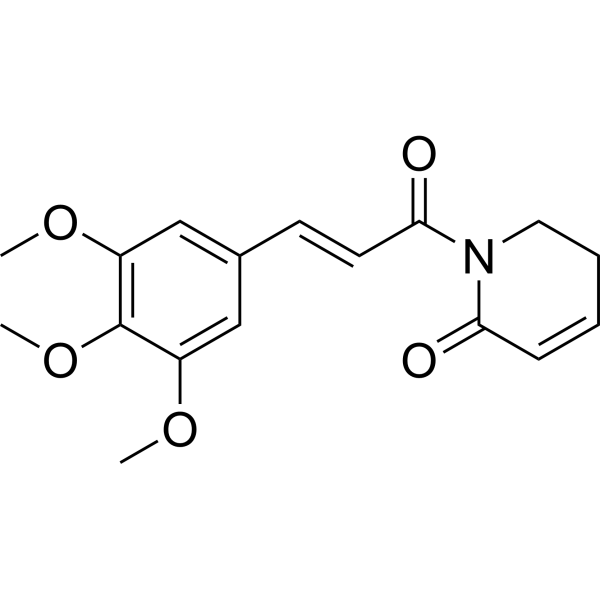| Synonyms: |
piperlongumine;(E)-1-(3-(3,4,5-TRIMETHOXYPHENYL)ACRYLOYL)PIPERIDIN-2-ONE;1-[(E)-3-(3,4,5-trimethoxyphenyl)prop-2-enoyl]-2,3-dihydropyridin-6-one;5,6-Dihydro-1-(1-oxo-3-[3,4,5-trimethoxyphenyl]-trans-2-propenyl)-2[1H]-pyridinone;5,6-Dihydro-1-[(2E)-1-oxo-3-(3,4,5-trimethoxyphenyl)-2-propen-1-yl]-2(1H)-Pyridinone;Piplartin;Piplartine;5,6-Dihydro-1-[1-oxo-3-(3,4,5-trimethoxyphenyl)-trans-2-propenyl]-2(1H)-pyridinone;(E)-1-[3-(3,4,5-Trimethoxyphenyl)acryloyl]-5,6-dihydropyridin-2(1H)-one;5,6-Dihydro-1-(3,4,5-trimethoxycinnamoyl)-2(1H)-pyridone;[
""
];Piperlongumin;PPLGM;SGD66V4SVJ;VABYUUZNAVQNPG-BQYQJAHWSA-N;(E)-1-(3-(3,4,5-trimethoxyphenyl)acryloyl)-5,6-dihydropyridin-2(1H)-one;ST079382;BRD2293;1-[(2E)-3-(3,4,5-trimethoxyphenyl)prop-2-enoyl]-1,2,5,6-tetrahydropyridin-2-one;(E)-5,6-Dihydro-1-[1-oxo-3-(3,4,5-trimethoxyphenyl)-2-propenyl]-2(1H)-pyridinone;(;PIPERLONGUMINE [MI];1-[(2E)-3-(3,4,5-Trimethoxyphenyl)-2-propenoyl]-5,6-dihydro-2(1H)-pyridinone #;HY-N2329;Piplartine;PPLGM;NSC-794671;EN300-7424497;NCGC00096028-02;CHEBI:92424;Prestwick3_000604;EX-A2925;2(1H)-PYRIDINONE, 5,6-DIHYDRO-1-(1-OXO-3-(3,4,5-TRIMETHOXYPHENYL)-2- PROPENYL)-, (E)-;SPECTRUM1505135;1-[(2E)-3-(3,4,5-trimethoxyphenyl)prop-2-enoyl]-5,6-dihydropyridin-2(1H)-one;CHEBI:8241;P2361;NCGC00096028-04;CCG-214375;SMR001233252;UNII-SGD66V4SVJ;PIPERLONGUMINE [INCI];BRD-2293;NCGC00096028-01;NCGC00096028-03;1-[3-(3,4,5-Trimethoxy-phenyl)-acryloyl]-5,6-dihydro-1H-pyridin-2-one;2(1H)-Pyridinone, 5,6-dihydro-1-(1-oxo-3-(3,4,5-trimethoxyphenyl)-2-propenyl)-, (E)-;LS-14579;s7551;20069-09-4;5,6-Dihydro-1-[1-oxo-3-(3,4,5-trimethoxyphenyl)-2-propenyl]-2(1H)-pyridinone, 9CI;Q7197361;HMS1569J10;FERROUSFLUOBORATE;Piperlongumine, >=97% (HPLC);BRD-K24132293-001-16-0;BRD-K24132293-001-05-3;A1-00162;CHEMBL465843;Prestwick_399;DTXSID801029762;Prestwick2_000604;BSPBio_000508;A920539;Prop-2-en-1-one, 3-(3,4,5-trimethoxyphenyl)-1-(2,3-dihydropyridin-6(1H)-one-1-yl)-;BDBM50462013;AC-32683;2(1H)-Pyridinone, 5,6-dihydro-1-[(2E)-1-oxo-3-(3,4,5-trimethoxyphenyl)-2-propen-1-yl]-;AKOS024284776;ACon1_001541;N-(3,4,5-Trimethoxycinnamoyl)-D3-piperidin-2-one;J-012992;NSC794671;HMS2234K24;HMS2096J10;MFCD00075706;MLS002153903;BPBio1_000560;Piperlongumine; Piplartine;NCGC00096028-14;CS-0021113;1-[(2E)-3-(3,4,5-Trimethoxyphenyl)-2-propenoyl]-5,6-dihydro-2(1H)-pyridinone;5,6-dihydro-1-[1-oxo-3-(3,4,5-triMethoxyphenyl)-allyl]-2(1H)-pyridinone;SCHEMBL173092;SCHEMBL2465593;SR-01000841248-2;SR-01000841248;BP-25401;5,6-Dihydro-1-(3,4,5-trimethoxycinnamoyl)-2(1H)-pyridinone;BRD-K24132293-001-09-5;AS-74140;BCP13030;"(Z)-piplartine;MLSMR;(E)-piplartine;PIPERLONGUMINE
[20069-09-4];NCGC00096028-06;GTPL13376;DA-66744;Piperlongumine? |






















